
28 Apr How a Dermatology Clinical Trial Improves Community Outcomes
The intervention of a dermatology clinical trial is an important phase for medical innovators who want to improve community outcomes. While some of these conditions are nothing more than an irritation, many others live with debilitating concerns that impact on their quality of life. To find breakthroughs and to enjoy success in this field, it is important for these programs to score backing and support from other groups.
Protects Community Health
Men, women and children who live with various forms of skin conditions know how important it is to see a free dermatology clinical trial for their benefit. When patients are diagnosed with anything from dermatitis to hives, eczema, acne, ichthyosis, psoriasis, rosacea or vitiligo, they require a treatment that will actually be effective, reducing the risk of incurring long-term effects that are impossible to resolve without surgery.
Providing Doctors With Better Treatments
In many cases, the positive work and breakthroughs that are undertaken at a dermatology clinical trial will find its way to a doctor’s office as they deliver prescriptions and medicines for their community members. Rather than having to live with the irritation and damage that is caused through these conditions, they will be in a better position to prescribe a pill, a cream or some form of treatment that will produce results in quick time, alleviating the pain and discomfort that would otherwise have been experienced.
Following a Structured Program
There is a wide misconception from some people when it comes to the subject of a dermatology clinical trial or any clinical trial for that matter. From their perspective, this is nothing more than random experimentation. Nothing could be further from the truth because these programs follow a very strict and regimented process, ensuring that individual health is not compromised. From Phase 1 where small groups are initially tested all the way through to Phase 4 where effectiveness is monitored, the outcomes are improved because the diligence of the work has been respected.
Backing For The Trial Process
There is no doubt that the existence of a dermatology clinical trial is an affirmation of the process from industry professionals. Once the green light has been given to run the program, then participants from the public and private sector have a chance to encourage or directly invest depending on the circumstances. That approach only works to foster more encouragement, helping to push the envelope further.
Pushing For Enterprise Competition
While there is a very important community health component at the top of the agenda for these medical innovators, there is also a degree of competition and finance at play for brands that want to be on the cutting edge of these treatments. If one side has found a revolutionary breakthrough during the process, that will lift the standard to new heights and be incredibly lucrative for those who have offered support and backing as they enjoy a stake in the outcome.
Improving Community Awareness & Knowledge
It is often through a dermatology clinical trial where certain chemicals and components will be found to deliver reactions to the skin that are positive and negative. While they might be already known inside internal medical circles and those battling chronic skin conditions, they might not be known for the wider community until they make headlines through these types of programs.
Reducing Costs
These trials are never cheap to run internally, but in the aftermath when operators are looking at the program from a distance, they realise that they do indeed reduce costs across the board for constituents. Without the aid of a dermatology clinical trial, men and women are left to pay for expensive surgeries and treatments that are experimental by nature, something that can be avoided with peer-reviewed studies through scientific approaches.

Sorry, the comment form is closed at this time.